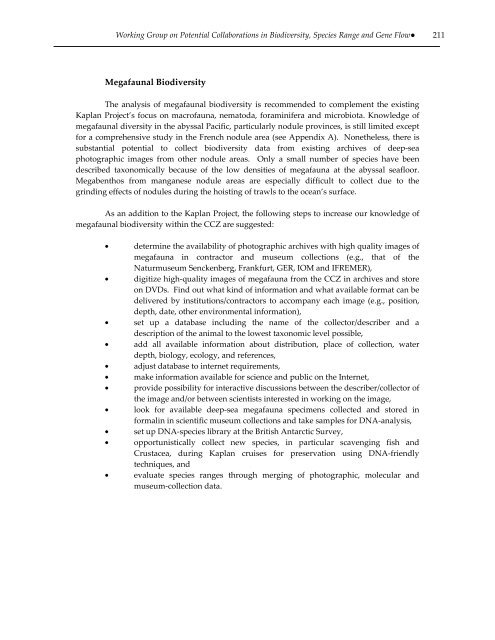PROSPECTS - International Seabed Authority
PROSPECTS - International Seabed Authority
PROSPECTS - International Seabed Authority
Create successful ePaper yourself
Turn your PDF publications into a flip-book with our unique Google optimized e-Paper software.
Working Group on Potential Collaborations in Biodiversity, Species Range and Gene Flow● 211<br />
Megafaunal Biodiversity<br />
The analysis of megafaunal biodiversity is recommended to complement the existing<br />
Kaplan Project’s focus on macrofauna, nematoda, foraminifera and microbiota. Knowledge of<br />
megafaunal diversity in the abyssal Pacific, particularly nodule provinces, is still limited except<br />
for a comprehensive study in the French nodule area (see Appendix A). Nonetheless, there is<br />
substantial potential to collect biodiversity data from existing archives of deep-sea<br />
photographic images from other nodule areas. Only a small number of species have been<br />
described taxonomically because of the low densities of megafauna at the abyssal seafloor.<br />
Megabenthos from manganese nodule areas are especially difficult to collect due to the<br />
grinding effects of nodules during the hoisting of trawls to the ocean’s surface.<br />
As an addition to the Kaplan Project, the following steps to increase our knowledge of<br />
megafaunal biodiversity within the CCZ are suggested:<br />
• determine the availability of photographic archives with high quality images of<br />
megafauna in contractor and museum collections (e.g., that of the<br />
Naturmuseum Senckenberg, Frankfurt, GER, IOM and IFREMER),<br />
• digitize high-quality images of megafauna from the CCZ in archives and store<br />
on DVDs. Find out what kind of information and what available format can be<br />
delivered by institutions/contractors to accompany each image (e.g., position,<br />
depth, date, other environmental information),<br />
• set up a database including the name of the collector/describer and a<br />
description of the animal to the lowest taxonomic level possible,<br />
• add all available information about distribution, place of collection, water<br />
depth, biology, ecology, and references,<br />
• adjust database to internet requirements,<br />
• make information available for science and public on the Internet,<br />
• provide possibility for interactive discussions between the describer/collector of<br />
the image and/or between scientists interested in working on the image,<br />
• look for available deep-sea megafauna specimens collected and stored in<br />
formalin in scientific museum collections and take samples for DNA-analysis,<br />
• set up DNA-species library at the British Antarctic Survey,<br />
• opportunistically collect new species, in particular scavenging fish and<br />
Crustacea, during Kaplan cruises for preservation using DNA-friendly<br />
techniques, and<br />
• evaluate species ranges through merging of photographic, molecular and<br />
museum-collection data.

















